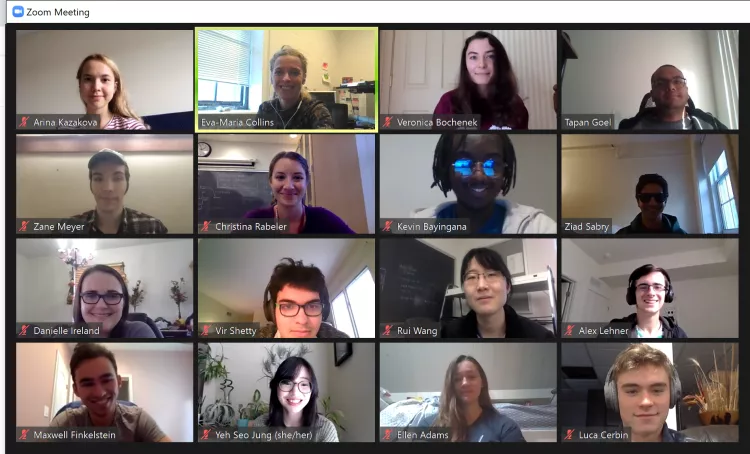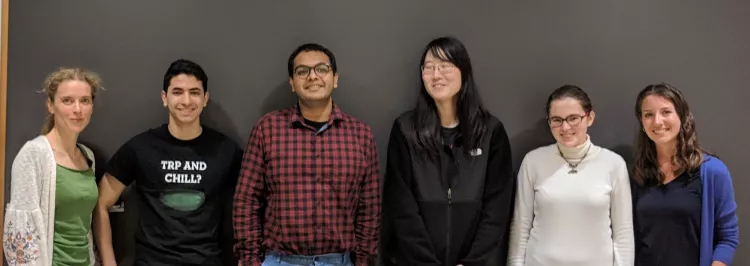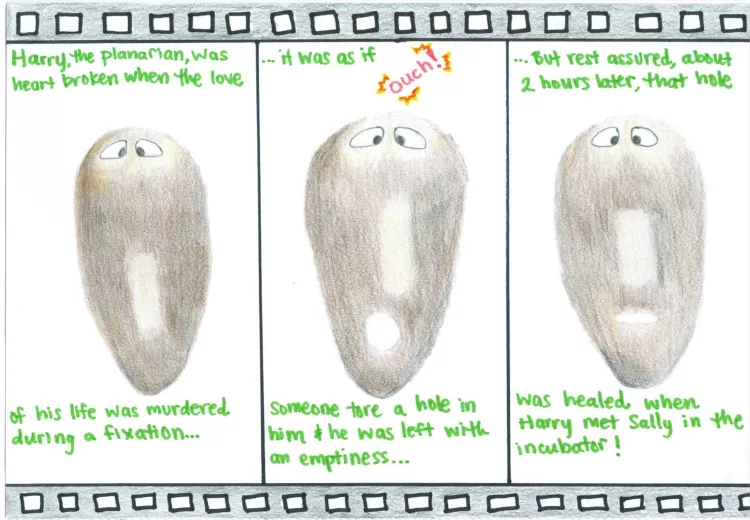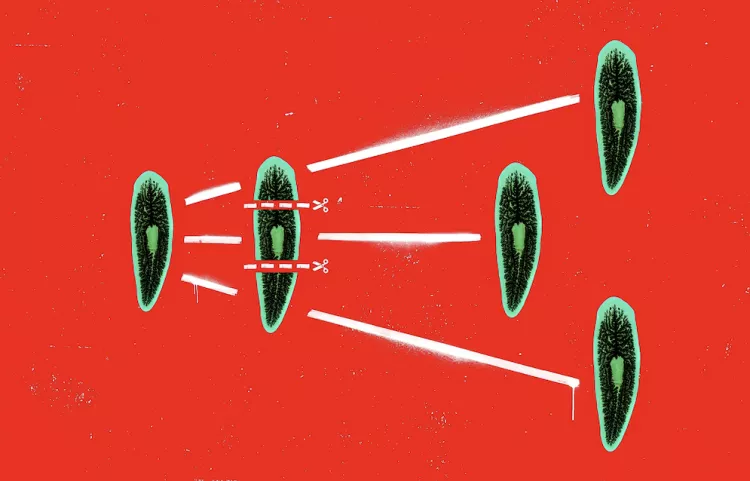Eva-Maria Collins
Associate Professor
On Leave - Calendar Year
Biology
Physics & Astronomy-Physics
Contact
Affiliations: Cognitive Science, Biology, Physics & Astronomy

courses research publications Positions available in the lab about eva-maria
Meet the Team

Eva-Maria on finding balance between work and family life: https://www.biophysics.org/blog/biophysicists-finding-balance-mothers-day-2017
Courses
Cellular & Molecular Biology
Team taught. An introduction to the study of living systems illustrated by examples drawn from cell biology, biochemistry, genetics, microbiology, neurobiology, and developmental biology.
BIOL 027. Systems Biology
Systems Biology is an innovative, cross-disciplinary approach that is rooted in the realization that it is difficult to understand biological systems from the study of individual components because living systems are more than the sum of their parts. Systems Biology aims to get at the big picture by using quantitative measurements of the properties and behaviors of interacting agents (molecules, cells, organisms, populations), bioinformatics, physics, and mathematical models, to capture and predict the dynamics of biological systems.
BIOL 126. Biomechanics in Development and Regeneration
Biomechanics investigates the interplay of mechanical forces and biological processes across scales, from nanomachines to whole organisms. This interplay is an important mechanism influencing key processes in embryonic development, disease, and regeneration of animals. Research in biomechanics also serves as inspiration for bioengineering and regenerative medicine. In this seminar, students will explore the primary literature in biomechanics through student-led discussions. Focus areas may include development, regeneration, or animal behavior.
BIOL 117. Trends in Pharmacology
Pharmacology investigates the mechanisms of drug effects from the molecular level to the whole animal. We will examine the mode of action of drugs, learn about drug design and development, xenobiotic metabolism and the cellular and organismal responses to drug exposure. Students will explore the field of pharmacology through student-driven discussion of primary literature. Topics will encompass landmark pharmacology papers as well as new approach methods.
BIOL 129. Developmental Neurotoxicology
In this seminar students will explore the field of developmental neurotoxicology, with an emphasis on alternative toxicology models and computational approaches. The seminar will encompass student-driven discussion of primary literature, ranging from landmark toxicology papers to new approach methods. Course content emphasizes statistical and quantitative methods.

Research
Physical Principles in Biological Systems:
Biomechanics, Neurodevelopment & Neuronal Control of Behavior
We are an interdisciplinary team of researchers interested in the role of physical principles for living systems. Currently, we are working in three major areas: Biomechanics, Neuroethology, and Neurotoxicology.
Our two main model systems are freshwater planarians and Hydra. Both organisms are famous for their incredible regenerative capabilities: one can cut them into many pieces and each piece will give rise to an entire new animal!
We use techniques from physics, engineering, and computer science, and combine them with molecular biology methods to investigate how structure and function influence developmental processes, regeneration, and asexual reproduction (in planarians).
Planarian asexual reproduction can be studied from the molecular level to the population level, allowing us to combine stem cell biology with tissue mechanics, statistical physics, evolution and aging. To this end, we developed a unique experimental system in which we track thousands of individual worms over the course of several years to study their reproduction dynamics.
Every time a planarian reproduces asexually by ripping itself apart, the tail piece needs to regenerate a new head and central nervous system. Thus, in this organism, regeneration and development occur through mechanistically similar pathways. We take advantage of this and use planarians as an in vivo model for developmental neurotoxicology.

Publications
Note: Undergraduate and school student authors are underlined.
Neurotoxicology and Planarian Behavior
S. G. Fuselier, D. Ireland, N. Fu, C. Rabeler and E.-M. S. Collins (2023), Comparative toxicity assessment of glyphosate and two commercial formulations in the planarian Dugesia japonica, Front. Toxicol. in: Emerging Talents in Toxicology. PMID: 37435546.
D. Ireland and E.-M. S. Collins (2023), Planarians as a model to study neurotoxic agents, Alternative Methods in Neurotoxicology in: Advances in Neurotoxicology (1st Edition - June 1, 2023).
D. Ireland and E.-M. S. Collins (2023), New Worm on the Block: Planarians in (Neuro)Toxicology, Current Protocols: Toxicology. PMID: 36571713.
D. Ireland, TaiXi Gong, Christina Rabeler, and E.-M. S. Collins (2022), Bioactivation and detoxification of organophosphorus pesticides in freshwater planarians shares similarities with humans, Arch. Toxicol. PMID: 36173421.
D. Ireland, S. Zhang, V. Bochenek, Jui-Hua Hsieh, Christina Rabeler, Z. Meyer, and E.-M. S. Collins (2022), Differences in neurotoxic outcomes of organophosphorus pesticides revealed via multi-dimensional screening in adult and regenerating planarians, Frontiers in Toxicology. PMID: 36267428.
D. Ireland, V. Bochenek, D. Chaiken, C. Rabeler, S. Onoe, A. Soni, and E.-M. S. Collins (2020), Dugesia japonica is the best suited of three planarian species for high-throughput toxicology screening. Chemosphere, PMID: 32298908.
Z. Sabry, A. Ho, D. Ireland, C. Rabeler, O. Cochet-Escartin, and E.-M. S. Collins (2019), Pharmacological or genetic targeting of Transient Receptor Potential (TRP) channels can disrupt the planarian escape response. Plos ONE, PMID: 31805147.
S. Zhang, D. Ireland, N. Sipes, M. Behl, and E.-M. S. Collins (2019), Screening for neurotoxic potential of 15 flame retardants using freshwater planarians. Neurotoxicology and Teratology, PMID: 30943442.
D. Hagstrom, L. Truong, S. Zhang, R. L. Tanguay, and E.-M. S. Collins (2019), Comparative analysis of zebrafish and planarian model systems for developmental neurotoxicity screens using an 87-compound library. Toxicological Sciences, PMID: 30011007. This paper was awarded the “Tox. Sci. Paper of the year 2019” by the Society of Toxicology.
S. Zhang, D. Hagstrom, P. Hayes, A. Graham, and E.-M. S. Collins (2019), Multi-behavioral endpoint testing of an 87-chemical compound library in freshwater planarians. Toxicological Sciences, PMID: 29893936.
D. Hagstrom, S. Zhang, A. Ho, E.S. Tsai, Z. Radic, A. Jahromi, Y. He, K.J. Kaj, P. Taylor, and E.-M. S. Collins (2018), Planarian cholinesterase: molecular and functional characterization of an evolutionarily ancient enzyme to study organophosphorus pesticide toxicity. Archives of Toxicology, PMID: 29167930.
D. Hagstrom, H. Hirokawa, Z. Radic, L. Zhang, P. Taylor, and E.-M. S. Collins (2016), Planarian cholinesterase: in vitro characterization of an evolutionarily ancient enzyme to study organophosphorus pesticide toxicity and reactivation. Archives of Toxicology, PMID: 27990564.
O. Cochet-Escartin*, J.A. Carter*, M. Chakraverti-Wuerthwein*, J. Sinha, and E.-M. S. Collins (2016), Slo1 regulates ethanol-induced scrunching in freshwater planarians. Physical Biology PMID: 27609598. (* first author)
D. Hagstrom, O. Cochet-Escartin, and E.-M. S. Collins (2016), Planarian brain regeneration as a model system for developmental neurotoxicology. Regeneration, DOI 10.1002/reg2.52.
D. Hagstrom, O. Cochet-Escartin, S. Zhang, C. Khuu, and E.-M. S. Collins (2015), Freshwater Planarians as a New Invertebrate System for Neurotoxicology. Toxicological Sciences, PMID: 26116028.
J.A. Talbot, K.W. Currie, B.J. Pearson, and E.-M. S. Collins (2014), Smed-dynA-1 is a nervous system specific dynamin in the planarian Schmidtea mediterranea required for normal locomotion. Biology Open, PMID: 24950970.
Biomechanics
R. Wang, T. Goel, K. Khazoyan, Z. Sabry, H.J. Quan, P.H. Diamond and E.-M. S. Collins (2019), Mouth Function Determines The Shape Oscillation Pattern In Regenerating Hydra Tissue Spheres. Biophysical Journal, PMID: 31443907
K. Chiou and E.-M. S. Collins (2018), Review: Why we need mechanics to understand animal regeneration. Developmental Biology, PMID: 29179947
O. Cochet-Escartin, T. Locke, W. Shi, R.E. Steele, E.-M. S. Collins (2017), Physical mechanisms driving cell sorting in Hydra. Biophysical Journal, PMID: 29262375. Featured as “New and Notable”.
P.T. Malinowski*, O. Cochet-Escartin*, K.J. Kaj, E. Ronan, A. Groisman, P.H. Diamond, E.-M. S. Collins (2017), Mechanics dictate where and how freshwater planarians fission. Proc Natl Acad Sci, PMID: 28973880. (* first author). Featured in Nature Physics.
J.A. Carter*, C. Hyland*, R.E. Steele, E.-M. S. Collins (2016), The dynamics of mouth opening in Hydra. Biophysical Journal, PMID: 26958895 (* first author). Featured as “New and Notable” and BPS “Paper of the year 2016”.
O. Cochet-Escartin, K. Mickolajczyk, and E.-M. S. Collins (2015), Scrunching: A novel escape gait in planarians. Physical Biology, PMID: 26356147.
E.-M. Schotz, M. Lanio, J.A. Talbot, and M.L. Manning (2013), Glassy dynamics in threedimensional embryonic tissues. Journal of the Royal Society Interface, PMID: 24068179.
M.L. Manning, R.A. Foty, M.S. Steinberg, and E.-M. Schotz (2010), Coaction of intercellular adhesion and cortical tension specifies tissue surface tension. Proc Natl Acad Sci, PMID: 20616053.
E.-M. Schotz (2008), Dynamics and Mechanics of Zebrafish Embryonic Tissues - A study of the physical properties of zebrafish germlayer cells and tissues and cell dynamics during early embryogenesis, VDM publishing group.
Population Statistics and Evolution
X. Yang*, K.J. Kaj*, D.J. Schwab, and E.-M. S. Collins (2017), Coordination of size-control, reproduction and memory in freshwater planarians. Physical Biology, PMID: 28467318. (* first author)
J.A. Carter, C.H. Lind, M.P. Truong, and E.-M. S. Collins (2015), To each his own: Reproductive Strategies and Success of Three Common Planarian Species: Schmidtea mediterranea, Dugesia japonica and Dugesia tigrina. J. Stat. Phys., DOi 10.1007/s10955-015-1310-1.
M.A. Thomas, S. Quinodoz, and E.-M. Schotz (2012), Size matters! Birth size and a size independent stochastic term determine asexual reproduction dynamics in freshwater planarians. J. Stat. Phys., DOI: 10.1007/s10955-012-0514-x.
S. Quinodoz, M.A. Thomas, J. Dunkel, and E.-M. Schotz (2011), The more the merrier? Entropy and statistics of asexual reproduction in freshwater planarians. J. Stat. Phys., DOI: 10.1007/s10955-011-0157-3. (this article was featured in the Ivy League Week)
J. Dunkel, J.A. Talbot, and E.-M. Schotz (2011), Memory and obesity affect the population dynamics of asexual freshwater planarians. Physical Biology, PMID: 21263170.
Developmental Biology
B.G. Lambrus, O. Cochet-Escartin, P.A. Newmark , E.-M. S. Collins*, and J.J. Collins* (2015), Tryptophan hydroxylase gene function is required for eye melanogenesis in the planarian Schmidtea mediterranea. Plos ONE, PMID: 26017970. (* corresponding author).
E.-M. Schotz, R.D. Burdine, F. Julicher, M.S. Steinberg, C.-P. Heisenberg, and R.A.Foty (2008), Quantitative Differences in Tissue Surface Tension Influence Zebrafish Germ Layer Positioning. HFSP Journal, Vol.2 (1), pp. 1-56.
F. Ulrich*, M. Krieg*, E.-M. Schoetz*, V. Link, I. Castanon, V. Schnabel, A. Taubenberger, D. Mueller, P.-H. Puech, C.-P. Heisenberg. Wnt11 Functions in Gastrulation by Controlling Cell Cohesion through Rab5c and E Cadherin , Developmental Cell, Vol.9, 555564 (2005). * first author.
Methods and Techniques
R. Wang and E.-M. S. Collins (2020), A novel bilateral grafting technique for studying patterning in Hydra. Developmental Biology, PMID: 32165148.
T. Goel, R. Wang, S. Martin, E. Lanphear, and E.-M. S. Collins (2019), Linalool acts as a fast and reversible anesthetic in Hydra. Plos ONE, PMID: 31648269.
C. Tran, S. Fu, T. Rowe, and E.-M. S. Collins (2017), Generation and long-term maintenance of nerve-free Hydra vulgaris, J. Vis. Exp.(125), e56115.
J.P. Dexter*, M.B. Tamme*, C.H. Lind*, and E.-M. S. Collins (2014). On-chip immobilization of planarians for in vivo imaging. Nature Scientific Reports, DOI: 10.1038/srep06388.
M.A. Thomas and E.-M. Schoetz (2011). SAPling: A Scan-Add-Print barcoding database system to label and track asexual organisms. Journal of Experimental Biology, PMID: 21993779.
J.A. Talbot and E.-M. Schotz (2011), Quantitative characterization of planarian wildtype behavior as a platform for screening locomotion phenotypes. J Experimental Biology, PMID: 21389189.
Outreach and Education
Vista SSEP Mission 11 Team, D. Hagstrom, C. Bartee, and E.-M. S. Collins (2018), Studying Planarian Regeneration Aboard the International Space Station within the Student Space Flight Experimental Program. Frontiers in Astronomy and Space Sciences, doi.org/10.3389/fspas.2018.00012
E.-M. S. Collins and T.R. Calhoun (2014), Raising the bar in freshman science education. Journal of College Science Teaching, Vol. 43 (4), pp. 26-35.
E.-M. Schoetz, S. Barolo, R.J. Full, O. Gigliotta, F. Grey, E.C. Guinan, J. Lee, A. Lindner, R. B. Lotto, D. Misevic, T. E. Murphy, J. Niemela, Z. Popovic, L. Riboli-Sasco, I. Riedel-Kruse, M.F. Schatz, T. Schaus, M.D. Shattuck, Ke. Showalter, K.O. Stanley, H.L. Swinney, L. Xu, and F. Taddei (2012). Training the next generation of "night scientists" (Workshop Summary), ICASE Newsletter_052012.

Immortal under the edge of knife: The astonishing abilities of planarians Work on planarian behavior by Professor Eva Maria Collins and her students was featured in The Atlantic
Positions Available
Post Doctoral Fellow- Neurotoxicology
The Biology department at Swarthmore College is accepting applications for a postdoctoral researcher who will conduct research under the supervision of Associate Prof. Eva-Maria Collins in the field of neurotoxicology. We are looking for a highly motivated researcher with excellent communication skills and a PhD in toxicology, pharmacology, computational biology, neurobiology, biomedical engineering, molecular biology, or closely related field. Training in toxicology is preferred but not required. Applicants with strong computational skills and/or an interest in instrumentation are especially encouraged to apply.
This NIH-funded position is for a research project aimed at using freshwater planarians as a New Approach Methodology (NAM) for developmental neurotoxicity studies of organophosphorus pesticides (OPs). The Collins group has pioneered the planarian system for high-throughput neurotoxicology (Zhang et al., Tox. Sci 2019; Hagstrom et al., Tox. Sci 2019). The successful candidate will be responsible for conducting a medium-size screen testing individual OPs, binary mixtures, and control compounds using our custom screening platform. Candidates will perform computational image and data analysis and statistics, and thus the candidate should ideally demonstrate extensive experience with computational analyses and bioinformatics. Interest in instrumentation is preferred but not required.
The successful candidate will work closely with undergraduate students at Swarthmore College. Therefore, demonstrated team work ability and a strong interest in mentoring undergraduate students is preferred. The postdoctoral fellow will be encouraged to lead the project, collaborate with the PI and undergraduate students on high-impact publications, and present at key conferences in the field.
To apply, candidates should submit their application materials, including a Cover letter, CV, most relevant publication, and email addresses of three references through the Swarthmore College Job Portal.
This is a limited term position and is on an annual renewal basis, with a maximum duration of 3 years. This position offers a competitive benefits package and paid time off. Click here to view employee testimonials and learn about what it’s like to be a part of the Swarthmore community.
Located in the immediate suburbs of Philadelphia and just 20 miles from Wilmington DE, Swarthmore College is a highly selective liberal arts college whose mission combines academic rigor with social responsibility. Swarthmore College actively seeks and welcomes applications from candidates with exceptional qualifications, particularly those with demonstrable commitments to a more inclusive society and world. Swarthmore College is an Equal Opportunity Employer. Women and minorities are encouraged to apply.
Applications will be considered immediately and on a rolling basis until the position is filled.
Please feel free to contact Eva-Maria directly with any questions.
Required Qualifications:
PhD in toxicology, pharmacology, computational biology, neurobiology, biomedical engineering, molecular biology, or closely related field.
Preferred Qualifications:
Candidates with training in toxicology and strong computational skills and/or an interest in instrumentation are especially encouraged to apply.
Swarthmore College actively seeks and welcomes applications from candidates with exceptional qualifications, particularly those with demonstrable commitments to a more inclusive society and world. Swarthmore College is an Equal Opportunity Employer. Women and minorities are encouraged to apply.



